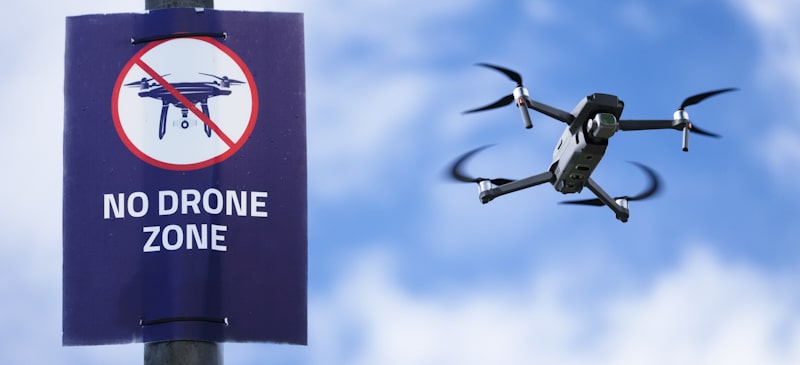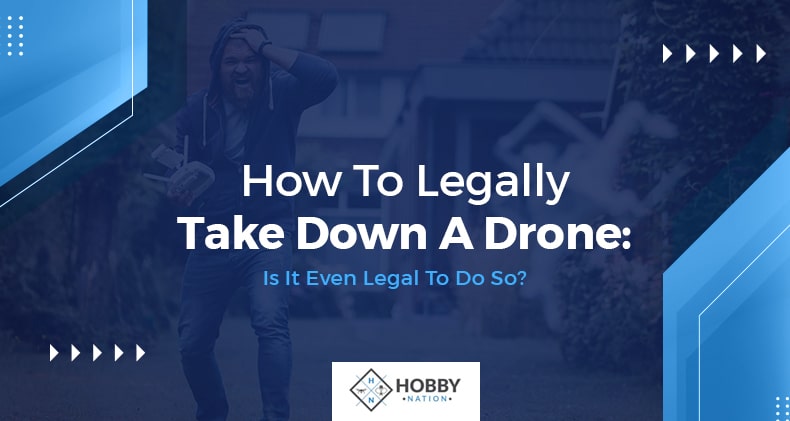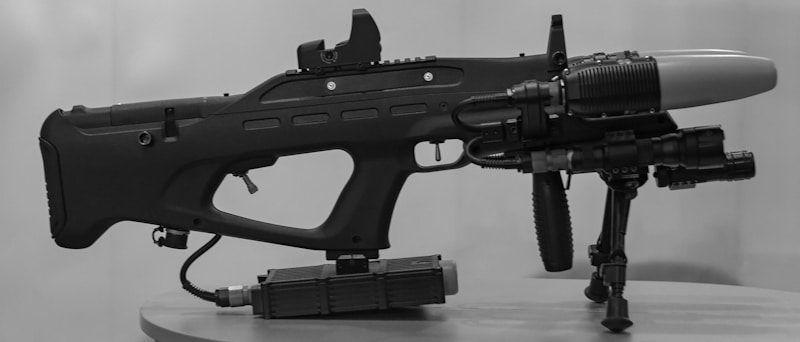When a drone starts flying over your home you may find it annoying. However, with approximately 1.3 million registered drones and more than 116,000 registered drone operators in the United States today, drones flying over homes is a growing problem. This may leave you wondering if it's legal to take down a drone.
It's a federal crime to destroy, damage, or interfere with a drone. This is because drones are classified as aircraft and therefore they're bound by the same laws. However, there are some ways in which you can legally stop a drone from flying over your own private property.
One of the things you can do is filing a legal complaint against the drone's operator. Keep reading as we explore more of what you need to know here.
Shooting Down a Drone
Not only is shooting a drone out of the sky extremely difficult, but it's also illegal. Although the majority of drones are so fragile that they'll shatter when a bullet hits them, they're also small and agile. As such, even a trained sniper who's working in a controlled environment will also struggle to shoot one down. Therefore the average marksman is unlikely to hit one. Instead, their bullet may injure someone or cause other damage on its way back down.
The Danger of Shooting Down a Drone
When you try to shoot down a drone, it's possible that not only are you risking other people's safety but you may also be faced with jail time. The reason shooting down drones is so dangerous is that they're run off of lithium polymer (a.k.a. Lipo batteries) which is a fire hazard. So when you bust a battery because you're shooting down a drone wherever the drone lands will catch on fire. Now you're not only responsible for the fire and its damage but you must also remember that the drone owner has legal rights and you've damaged their property – something else that you're responsible for.
Using Net Guns to Take Down a Drone
Net guns that are used in taking down drones resemble those that are used in animal control. These are about the size of a large flashlight. It's important to understand that these are close-range weapons. Therefore they're unable to reach a drone if it's hovering over 50 feet away from you.
There are some companies who've tried to fix this issue by mounting a net gun on a drone so that they could carry out an air-to-air-attack. One example of these is Theiss UAV Solutions' EXCIPIO Aeriel Netting System. It's able to catch up to a rotary-ring drone – something that'll significantly extend the range of its net. Nevertheless, it's still tricky to take down another drone, which is why the company is working on sensors and autonomous controls so that it can lock onto its target.
Even if you're able to use a net gun to take down a drone you still have the problem of where this drone is going to land. It's possible that it may accidentally fall on someone. This is something that some net guns have thought about. For instance, the French have built the Drone Inceptor MP200 which flies with an unfurled net that's used to entangle targets. Unfortunately, this has affected the mechanism's speed and maneuverability though. Then there's the Drone Catcher which was developed by Michigan Tech University's Human-Interactive Robotics Lab. It fires a net with a tether. If the drone happens to be too big to carry away it can then be released, allowing it to parachute downwards.

Since there's no discharge of a firearm or signals interference here your local and state authorities will likely be fine with you using a net gun if it's on your own property but you could still get in trouble with the FAA. However, you'll have to be really good at using one since most systems need to be reloaded after a single shot. If you mount a net gun on a drone then you'll have to always have it ready to launch.
Jamming a Drone
Drones have both a transmitter and a receiver. This means that it uses various frequencies of radio waves to communicate with its controller. These can be GPS, WIFI, or handheld.
Jamming equipment emits a signal on the drone's frequency to disrupt its communication. In doing so you're disrupting the drone's signal but you could also be inadvertently interrupting the transmission of other radio signals (e.g. police radios) at the same time. This is why it is illegal for a person to jam any type of radio signal. In fact, federal law not only prohibits the use of any type of equipment that interferes with authorized radio communications but it also prohibits the sale of any such equipment. This law also applies to anyone who tries to jam the signal between a drone and its operator.
You should also know that just because you've jammed a drone's signal doesn't mean that you have control of the drone. This is because when a drone loses its signal it'll either land on the spot or use GPS to navigate its way back to its home location.
Drone Hijacking
The difference between jamming and hijacking a drone is that when you jam a drone you're simply disrupting the operator's control. If you hijack a drone you can take control of it and force it to land.
There are two main ways in which you can hijack a drone:
- You can radiate a rival command signal that'll overpower the initial signal. As the drone flies away from its operator it will become weaker.
- You can transmit malicious code that'll hack the drone.
To radiate a rival signal you'll need to have a little knowledge. For instance, if you're dealing with a hobby drone you need to know that it uses WiFi in the 2.4 gigahertz frequency range. Its command signal is an open standard waveform so there is no special transmitter required. Really all you need is an iPhone, an app, and a power amplifier. Since the drone's receiver will be unable to determine where the command signal is originating from it'll use the network's strongest signal. This is how you take control of the drone.
Since there's no discharge of a firearm or signals interference here your local and state authorities will likely be fine with you using a net gun if it's on your own property but you could still get in trouble with the Federal Aviation Administration (FAA). However, you'll have to be really good at using one since most systems need to be reloaded after a single shot. If you mount a net gun on a drone then you'll have to always have it ready to launch.
Unfortunately, you can't hack a simple, hardwired RC drone. You'll also find that it's challenging to do this across a wide range of drones. Furthermore, this really isn't something that most homeowners would even know how to do.
Spoofing
Another method that's used to disrupt the normal communication between a drone and its operator is what's known as spoofing. This involves using hardware or software to spoof a signal that's used to communicate with the drone. In doing so the spoofer is able to take control of the drone. Depending upon what type of equipment is used, the person who's doing the spoofing may also be able to access the drone's data or view its camera's feed. Spoofing is also illegal in the United States.
Shining Lasers and Bright Lights at Drones
While you may be tempted to shine a laser pointer or a bright light at a drone, doing so won't do anything in terms of interfering with the drone's communication. It is also a violation of both federal and state laws since a drone is considered a type of aircraft. This means that if you're not allowed to do it with an aircraft, you're not allowed to do it with a drone and if you're caught doing this you could be faced with both jail time and fines.
Drones Flying Over Homes
It's legal for drones to fly over homes in most areas. Navigable airspace is controlled by the FAA. This includes everything above and beyond a home. However, anything under 400 feet is uncontrolled airspace. Recreational drone operators are permitted to fly in this air space without the FAA's approval. This means that drone operators won't get in trouble unless they're flying under the tree line or on top of your roof.
It's important to note that these laws and regulations do vary throughout the country. There are some states in which a homeowner owns the space up to 83 feet from the ground. However, in other states, there's no definition for a property's height. Drone operators are also subject to restrictions that are set forth by homeowners and neighborhood associations. Some of them don't allow drones to be flown over residential neighborhoods.
Law Enforcement and Drones
The RE-authorization Act for the Federal Aviation Authority was passed by the federal government in 2018. There's a provision in this law that allows government authorities to shoot down privately owned drones that they believe are a threat. Prior to passing this law, law enforcement agencies weren't permitted to shoot down or attempt to jam a drone. However, officers in Louisiana and Utah have always been allowed to disable drones that either endangered the public or were caught flying over wildfires.
Drones Recording in a Person’s Backyard
There are several important considerations, including local laws, that determine whether a drone is able to record a homeowner in their own backyard. One such consideration is how the yard and its surrounding features are laid out. For instance, a backyard that's completely enclosed with a privacy fence and gate will give a homeowner a reasonable expectation of privacy. Therefore any drone that's caught recording someone there may be in violation of privacy laws. However, if there is no such fence, or there is a chain-link fence, the property is shared with another property or the property somehow remains visible to the public then the homeowner has no reasonable expectation of privacy. As such, a drone that records here isn't violating any privacy laws.
How to Legally Stop Drones From Flying Over Your Home
Legally, drones can fly over private property. However, according to FAA regulations they cannot do so in a reckless manner. Unfortunately, the FAA typically won't get involved if a homeowner claims that a drone operator is flying recklessly. Instead, they'll tell you to contact your local law enforcement agency. When you make this contact you'll be asked for proof that the drone was flying recklessly – something that's challenging at best. Therefore homeowners are really limited when it comes to their options in legally taking down a drone.
One of the first things you should do is talk to your homeowners or neighborhood association to see if there are any restrictions regarding flying drones over residential properties. If they do exist, you can have law enforcement intervene to force the drone's operator to stop flying there.
You can also check your local laws to see how property boundaries are defined. In some jurisdictions, it'll be clearly stated how high a homeowner can build a structure on residential property. When a drone is caught flying within this boundary it's considered a form of trespassing. Laws state that inanimate objects (e.g. a branch from a neighboring tree) can trespass on a property and a homeowner can take reasonable action when this happens without facing any legal consequences. So if a drone is flying on your property's boundary and you get the photographic proof you can file a complaint with your local authorities. They may then file charges against the operator for trespassing on private property.
You may also choose to file a complaint alleging that the drone's operator is creating a nuisance. This is defined as an unnecessary action that disrupts the reasonable enjoyment of your property (e.g. a car blasting its horn, someone yelling, a drone's whirling blades).
Your final option is to file a complaint that alleges an invasion of property. This is what you'll want to do if you believe that a drone is being used to spy on you, your family, or your property. If you're able to provide a judge with sufficient evidence here, you may receive a restraining order against the drone's operator.
The Legalities of Taking Down a Drone
It's important to remember that you don't own the airspace above your home so you can't claim self-defense if you shoot down a drone. Instead, all airspace is under the FAA's jurisdiction. Furthermore, you'd have to prove that a drone posed a threat of deadly force to claim you're acting in self-defense. This would mean that the drone would have to be equipped with a weapon.

Besides dealing with federal, state, and local laws, homeowners must also deal with civil laws. A drone's owner can sue you in civil court if you destroy their property. For a variety of legal reasons, it's illegal to shoot down a drone in the United States even if it's flying over your private property. There are several reasons for this, including:
- Shooting at and destroying aircraft is a federal crime under Title 18 US Code 32. According to the FAA, drones are classified as a type of "aircraft."
- Sometimes merely firing a weapon is considered criminal mischief. There may also be additional state and local laws here. For instance, in some areas, you may also be charged with endangering the public or various property crimes.
- Homeowners don't own the airspace that's located above their properties.
- It's not a viable option for you to claim self-defense.
- You can be sued by the drone's operator in civil court.
Knowing that you can't legally shoot down a drone may leave you feeling helpless if you find one hovering over your home. However, you should know that there are some things that you can do, including:
- Try to figure out who owns the drone so that you can calmly talk to them about what they're doing and how it's bothering you. You'll be pleasantly surprised to find that most people are actually quite reasonable. This shouldn't be difficult to do either since most drones only fly within a short distance of their operators since they have a limited amount of battery power. However, if you try to go this route and they're being unreasonable you can choose to get law enforcement involved.
- Call law enforcement if you really believe that the drone is down to tree-top level and hovering in order to spy on you. There are nuisances and peeping Tom laws that can be enforced here.
Wrapping Things Up
While you can't shoot down drones because it's illegal to do so, there are some things you can legally do to ensure that you aren't being harassed in your own home. Acting reasonably and responsibly here is important even when the drone owner isn't doing so.
Continue Reading: RC Shooting Tanks: Best Tanks With Working BB Guns
Shawn Manaher loves to play with new toys and dive into new hobbies. As a serial entrepreneur, work definitely comes first but there is always room for hobbies.



